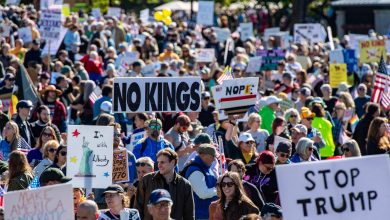
What Is the State and Who Controls It?
What Is the State and Who Controls It?
by Jeffrey A. Tucker at Brownstone Institute
What is the state, from whence does it come, and who controls it? One might suppose these questions have obvious answers. In reality the answer is elusive, not easily identified even by those who are part of the system.
Trump found this out in his first term. He naturally assumed that the president would be in charge, at least as regards the executive branch. He found out otherwise when the agencies worked closely with the media to undermine him at every step. After a four-year hiatus, he came back with a real determination to be the president.
It’s easier said than done. Cabinet-level appointees frequently complain in private that they face intractable bureaucracies with all institutional knowledge. They often feel like stand-ins or mannequins. Trump is the unusual president who has even attempted to be in charge. Most are just happy for the emoluments of office and the plaudits that come with it.
In any case, anyone who reaches the heights in any state apparatus discovers that it is something different from anything described in the textbooks.
Plato conceived of the state as organic to life itself, mirroring the structure of the human soul. The polity was divided between the rulers (philosopher-kings), the guardians (warriors), and the producers (workers). The state exists to achieve justice, where each class performs its designated role harmoniously.
Aristotle offered a more realistic view. While the state is organic, it is not soulful. It has definite functions to promote the well-being of all through laws and education, balancing the interests of different classes. Aristotle favored a mixed government to prevent tyranny and promote stability.
Moving forward to the Enlightenment period, theories of the state in the West evolved with the advance of technology and economics. Thomas Hobbes saw the state as essential for stopping civil war between factions. Without it, life would be solitary, nasty, brutish, and short. To be sure, he was writing in the midst of the English Civil War.
John Locke in his Second Treatise on Government also saw the state as essential but extremely limited. Its job was to protect property and essential rights. It could also be overthrown under conditions of tyranny. The issue was personal to him as a victim of the trauma of war, revolution, and censorship.
Locke was the author of the template of what later became the Declaration of Independence. Here we find the view that the state is the “necessary evil,” a perspective largely accepted as true by the US Founding Fathers.
Soon after, the Hegelian view was born within the Platonic tradition. G.W.F. Hegel valorized the state as god marching on earth, the gathering force of social firmament to bend history to the inevitable conquest of rightful victors. This view was picked up on the right (national socialism) and left (international socialism) to infuse other conceptions of the state with an air of inevitability.
All this talk of the organic and essential character of the state struck a more radical tradition of thought as hopelessly naive. Franz Oppenheimer wrote that the state is an inorganic invading force, a conquering force, and always unwelcome, an institution exogenous to society itself.
This view was pushed by Albert Jay Nock and later Murray Rothbard, both of whom saw the state as inherently exploitative. The solution was simple: get rid of it once and for all, but not in the way Marx imagined. The result of the absence of the state would not be utopia but something closer to what Locke imagined: a well-functioning and peaceful society organized based on ownership and voluntary cooperation.
A deeply informed historical perspective on the state is offered by Bertrand de Jouvenel. In his view, the state is organized out of the firmament of society itself as natural elites gain the confidence of the public in matters of settling disputes. The elites constitute themselves as arbiters and cultural figures, gradually gaining monopoly control over the legal use of coercion in society. This view was backed by Erik von Kuehnelt-Leddihn, Hans-Hermann Hoppe, and, in our time, Auron MacIntyre. Each has a spin on the particulars they are discussing but all agree that the state is a product of elites for both good and ill.
There is a vast literature on this topic, of course. Every ideology offers a theory of what the state is and what it should be. A view that seems close to my own best intuition about how the state of the last century works comes from Gabriel Kolko in his history of the Progressive Era.
In his view, it’s not just any elites that form the drive of state policy but industrial elites in particular. Taking the history of modern industrialism, he found dominant industries at the heart of every agency. The Safe Food and Drug Act of 1906 was formed by industry seeking partnership with power to throttle market competition. The Federal Reserve is a cartel of banks. The Commerce Department is a product of industrial organizing too, as is the Department of Labor.
All these institutions embody what James Burnham called the managerial revolution. This consists in industrial elites touting their scientific prowess and organizing capacity which they saw as superior to the chaos of natural society and markets. Give the meritocrats power and resources and they will do a much better job than the people at bringing rationality to economic life and social/cultural organizing. Others writing in this tradition are C. Wright Mills, Philip H. Burch, G. William Domhoff, and Carroll Quigley.
From this literature, we gain a picture of the state we have inherited in our time. Indeed, no living person has known any other. All slogans of democracy and freedom aside, the state as we know it consists of an aspirational cartel of dominant industrial interests in every sector which are engaged in ongoing conspiracies against a free and competitive marketplace. We don’t normally think of the state as this, but this seems like the most realistic conception of what it actually is and does.
Consider the FDA. Its driving force is industry, which pays half its bills and shares in intellectual property rights with industry itself and its sister and parent agencies of the NIH, CDC, and HHS. Pharma is by far the biggest influence in the operation of these agencies, which is why Robert F. Kennedy, Jr., a sworn enemy of pharma, has such enormous trouble in managing them and redirecting their priorities. This should not be shocking since this was its very origin: industry seeking legitimacy and protection from the wiles of consumer sovereignty.
That same drama affects all attempts of reform at the Federal Reserve (banks), Department of Agriculture (Big Ag), Housing and Urban Development (housing developers), the Department of Education (teachers’ unions), the Department of Transportation (trains and autos), and the Department of Defense/War (munitions manufacturers). Everywhere you look in Washington today, you find the hand of mighty industrial players. It’s this way in most parts of the world.
This industrial state has at least three layers. It has a deep layer consisting of intelligence agencies and their benefactors and partners in industry. The NSA and CIA contract out most of what they do to digital companies in the private sector with classified results. There is the retail (or shallow) layer in which the regulated industries carry out the wishes of captured agencies; that’s why CVS removed therapeutics from its shelves in favor of modified mRNA shots and why the medical establishment jumped on board the Covid response with such enthusiasm. And it has the middle layer of the agencies themselves who arranged all the transfers.
If this is the state in our own times, what about the past? Does the model pertain? Perhaps if we speak of the Church as an industry, we can see the same forces at work in the Middle Ages. If we think of military establishments as industries, we gain a different outlook on what drove ancient states in Rome and Athens as well.
How does this tactile and slightly dark outlook at the genesis and functioning of the state fit with older theories? It puts to rest the idealism of Plato and Hegel, brings an element of realism of Hobbes and Locke, adds substance to Marx and Rothbard, and puts some flesh on the bones of theories of de Jouvel and Hoppe.
So far as we can tell, it’s actually the most accurate description of the reality of modern statism available. And this further underscores the enormous challenge of any temporary managers who purport to be draining the swamp, eliminating agency capture, or otherwise curbing corruption. The trouble is that the whole of the state apparatus is in fact the swamp. Capture is of the essence. Corruption is baked into state operations.
None of which means that reform is not worth trying. But it’s crucial to understand that none of the machinery of state is set up to be adaptable to reformers and democratic pressure. All momentum is in the opposite direction. Already what has happened in Trump 2.0, even with the limited successes we’ve seen, is the anomaly. It will take a miracle to make further dents but it can happen.
One of the wisest statements in the history of political theorizing comes from David Hume. In his view, the role of public opinion is crucial in all exercises of power. When the public mind changes, the state has no choice but to go along.
“Nothing appears more surprising to those, who consider human affairs with a philosophical eye, than the easiness with which the many are governed by the few; and the implicit submission, with which men resign their own sentiments and passions to those of their rulers. When we enquire by what means this wonder is effected, we shall find, that, as Force is always on the side of the governed, the governors have nothing to support them but opinion. It is therefore, on opinion only that government is founded; and this maxim extends to the most despotic and most military governments, as well as to the most free and most popular.”
Changing the public mind: this is the essential task.
What Is the State and Who Controls It?
by Jeffrey A. Tucker at Brownstone Institute – Daily Economics, Policy, Public Health, Society
The post What Is the State and Who Controls It? was first published by The Brownstone Institute, and is republished under a Creative Commons Attribution 4.0 International License. Please support their efforts.



